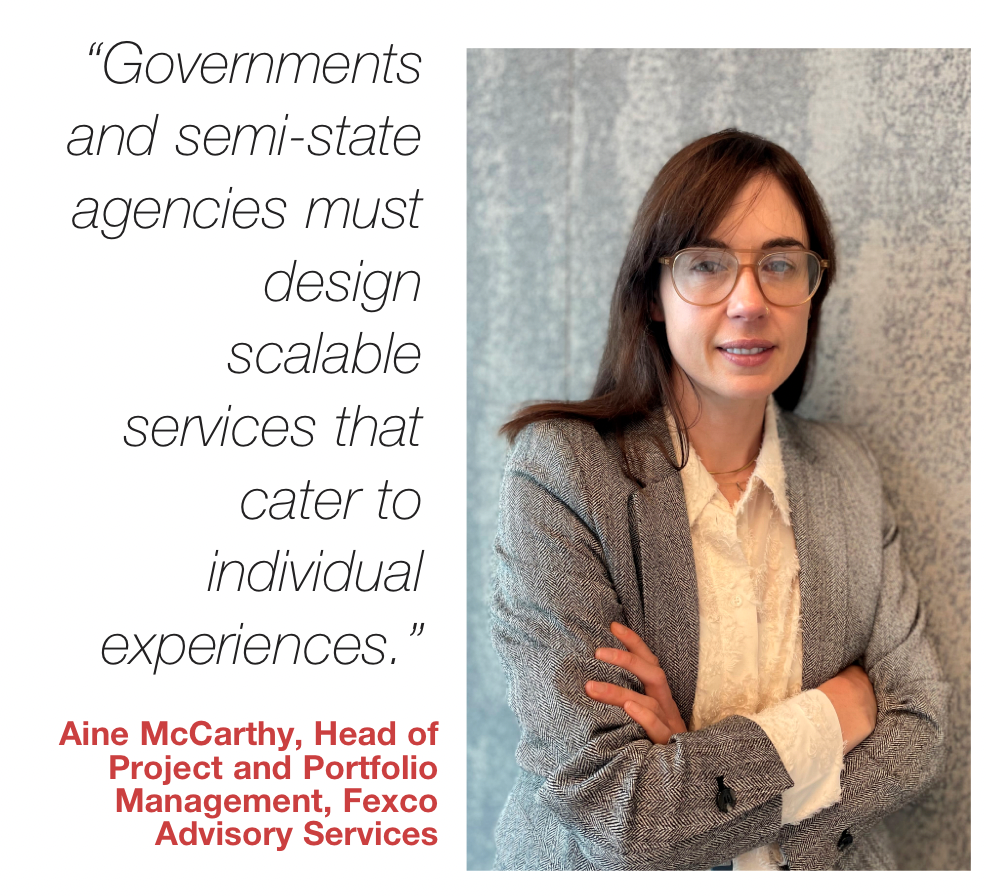Where to now for successful digital government in 2024?

Two years ago, the Government introduced the Connecting Government 2030 strategy, aiming to create a trusted, human-driven, intuitive, and inclusive digital government service by 2030. The ambitious objectives include having 90 per cent of applicable services consumed online and 80 per cent of eligible citizens using MyGovID by 2030, writes
Aine McCarthy, Head of Project and Portfolio Management, Fexco Advisory Services.
In November 2023, Fexco hosted a round table with key stakeholders from the public, semi-state, and private sectors to discuss enhancing citizen and business engagement amid pervasive digital disruption. The focus was on the steps necessary to achieve the vision set out in the strategy.
In December 2023, the Government followed up with the Designing Better Public Services action plan prepared by the Department of Public Expenditure, NDP Delivery, and Reform in Ireland. It outlined a comprehensive roadmap for embedding design principles and practices into public service delivery from 2024 to 2025. The plan emphasises a human-centric, collaborative, and innovative approach to redesigning public services to address contemporary challenges such as fiscal constraints, climate change, social inequality, and evolving demographics.
Where are we now? With so much change and disruption as new technologies make their presence felt, what does that mean for designing these engaging services for the public?
Designing for public buy-in
Evolution is crucial. Whether for public or private sector services, expectations are changing at an unprecedented pace. At its core, these expectations revolve around the human experience.
Citizen and business engagement thrives when the human experience is prioritised in service design, allowing technology to enhance personal human experiences rather than replace them. Providing good service involves not only convenience but also personalisation. Governments and semi-state agencies must design scalable services that cater to individual experiences.
During our session in November, participants discussed how citizens now expect personalized services across all sectors, driven by advancements like generative AI, which require robust data and processes to be effective and secure. They also emphasized the need for agility and openness to change from both technological and cultural perspectives.
How do you reflect these decisions in designing services for the public? From a Fexco perspective, we would suggest the following principles as the top 10 rules for designing services:
- Put people first in design.
- Design services to be inclusive.
- Design our services together with key stakeholders.
- Design for user trust.
- Design in such a way that knowledge can be reused and shared.
- Challenge assumptions and design with evidence.
- Design from the top down and bottom up.
- Design to deliver value in all its forms.
- Always build, test, learn, and iterate.
- Design to make things simpler.
A good example is the Passport Service home and renew their passports within a week, improving trust and satisfaction. The service builds on these principles and has seen demand rise with over 480,000 passports issued already in 2024.

Key design drivers: Enhancing user experience
As Ireland continues to digitally transform its public sector, several key trends shape the landscape, with a focus on designing to enhance user experience, promoting sustainability, and ensuring inclusive access to digital public services. These trends highlight the importance of customer-centric approaches and practical steps the government can take to drive digital transformation effectively.
Digital infrastructure: The National Broadband Plan aims to provide gigabit connectivity to all Irish households and businesses by 2028 and ensure 5G coverage in all populated areas by 2030. This will be a vital milestone that will see rapid adoption by the public of new services.
Digital skills and literacy: According to the most recent CSO Digital Literacy Report, in 2023, 35 per cent of internet users accessed information stored about them by public authorities, such as checking their pension or employment status. Additionally, 16 per cent accessed publicly available information in electronic databases like property registers. Over 44 per cent made appointments or reservations via websites or apps with public services, such as library bookings or government appointments. Six in 10 users sought information online about benefits, entitlements, services, and laws, with females more likely than males to request benefits or entitlements. Around 16 per cent requested official documents or certificates.
This report is encouraging. However, any service should not only cater to growing demand but also be accessible to people whose digital literacy levels may fall below the standard, ensuring that elderly and vulnerable adults are catered for. Over time, the Government’s 10-year Adult Literacy for Life Strategy will promote high-level digital skills through higher education and training programs.
Data utilisation and privacy: Effective use of data is crucial for improving public services. The Government plans to implement robust data management structures that respect privacy and enhance the reuse of data to inform policymaking and service delivery.
Optimising customer experience
A central theme in Ireland’s digital government strategy for public service design is creating a user-centric experience, which involves understanding user needs, simplifying service access, and ensuring consistency across various platforms. Prioritising a human-driven digital experience makes services more intuitive and accessible, engaging users to gather feedback and improve service design and delivery. Simplifying service delivery through an ecosystem of standards, resources, and tools, including the “once-only” principle where citizens provide information once for reuse across services, enhances efficiency.
Ensuring digital services are inclusive is critical, with a digital inclusion roadmap supporting those lacking internet access or digital skills to ensure no one is left behind.
Practical frameworks for effective public sector design
To enhance the design of digital government services effectively, several practical steps are essential. First, establishing strong governance structures is crucial to oversee digital transformation efforts. This includes creating cross-sectoral groups and digital leaders’ forums to ensure cohesive and collaborative leadership across all levels of government.
Next, continuous investment in digital skills and literacy programs for both public and civil servants is necessary. This ensures the workforce is well-equipped to handle new digital tools and processes, fostering a culture of innovation and adaptability within government services.
Engaging with stakeholders through regular consultations is another vital step. By gathering feedback from citizens, businesses, and other stakeholders, the Government can adjust strategies to better meet the needs of all users. This collaborative approach helps build trust and ensures that digital services are user-centric.
However, despite these steps, this is an enormously complex task and without a clear structure and process, public sector service providers could find themselves overloaded with demands and considerations to balance, and potentially design something that may not achieve any of those needs.
Focusing on digital and user experience is crucial today, as public service consumers’ demands and expectations are at an all-time high as we continue to effectively modernise its public services through a human-centric lens, across a wide range of public services such as an efficient tax system. As an operator of services on behalf of both the public and private sector that interacts with millions of individuals and businesses in Ireland on an annual basis, Fexco has a clear view of what makes a good user experience, and we have defined our definition and framework of what digital is which may help when designing public services.
From our decades of working with both the public and private sector, we have devised a framework can inform and guide critical steps and milestones for successful design.

D.I.G.I.T.A.L Framework
Design for personalised experience, at scale.
- Segment the user base into logical personas or groupings.
- Design services to ensure a positive, personal experience per segment.
- Integrate services and data to personalise the experience to the individual. Involve and learn from your users.
- Hold user focus groups during design and use customer feedback to improve continuously.
- Regularly map the customer journey and be open to adjusting business processes for better experiences.
Gather and use data to determine what is possible in the future but harnessing the power of the past.
- Record and analyse user behaviour to define the optimal journey.
- Track channel shifts to identify broken journeys gather and act on user feedback and insights.
- Use predictive analytics models for future experience requirements.
- Integrate and share systems and data:
- Design all new services to share relevant data.
- Seek and integrate relevant systems and data to enhance the user experience and supporting a personalised experience.
- Continuously challenge and remove barriers to sharing.
- Try new things:
- As the world around us evolves, so too will the tools and technology around us. AI, IoT, quantum computing are examples of current disruptors, but will be accompanied by many more advancements in the future.
- Embrace the change and try the new, focusing on identifying real improvements for the user experience.
- Automate:
- Seek opportunities to automate processes that will improve a user experience, either in an assisted or unassisted capacity.
- Automate user interactions that are trusted and provide certainty to customers, but design to allow for human interaction if required. Learn and adapt in an agile manner.
- Continuously review and learn from the past to help shape the future.
- Leverage learning from other industries to shape your own.
- Be curious and challenge the status quo.
- Be agile and change fast if the need arises.
Finally, implementing robust monitoring and evaluation frameworks is essential to track progress and measure the impact of digital initiatives. By ensuring that goals are met and identifying areas for improvement, the Government can maintain a high standard of digital service delivery and continually refine its strategies to adapt to changing needs and technologies.
Conclusion
Ireland’s journey towards a leading digital government is well underway, driven by a comprehensive strategy that prioritises user experience, sustainability, and inclusivity. However, it is always a good idea to sense check that progress aligns with the overarching strategy, and where necessary to be flexible to ensure that the result is readily adopted by the public.
With a rapidly changing environment driven by technology, it is tempting to adopt the latest technology, but without consideration of the public’s needs, you could find yourself in a technologically designed cul-de-sac that will drain resources and not be utilised by the public. This should inform your design framework, to ensure the design process does not flounder due to excessive and competing agendas.
Two years (and three round tables later), we see that with these key trends combined with taking practical steps to implement them, the Irish Government can design and enhance public services, support economic growth, and contribute to a more sustainable future.

W: www.fexco.com





